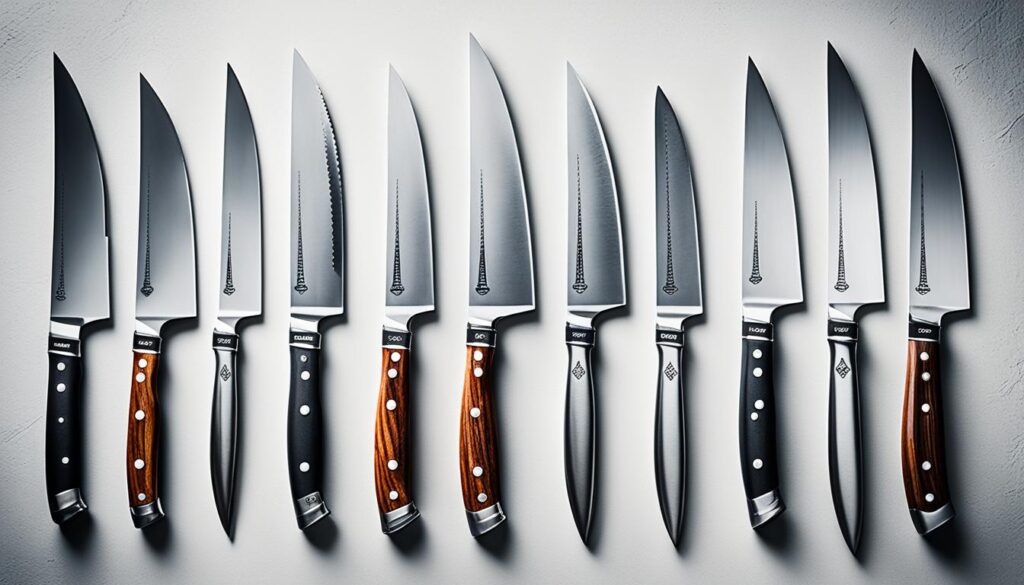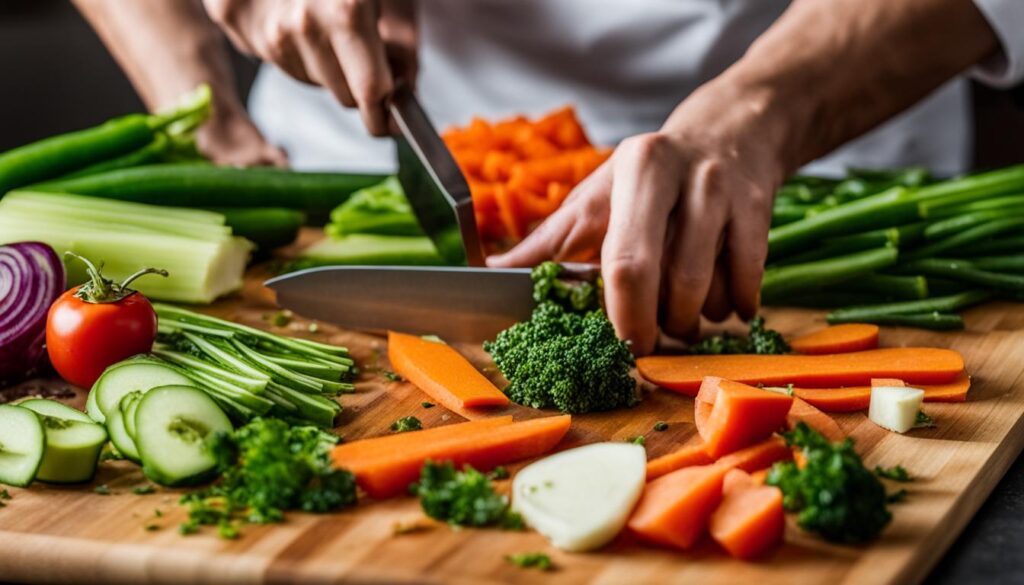Mastering knife skills is essential for anyone who wants to become a proficient cook. Knowing how to chop, slice, and dice like a pro can not only save you time in the kitchen but also ensure that your ingredients are prepared consistently and safely. In this article, we will explore the fundamentals of knife skills, including proper grip and technique, the different types of knives you should have in your kitchen, and the essential cutting techniques that will elevate your culinary abilities.
Key Takeaways:
- Knife skills are crucial for efficient and safe cooking.
- Proper grip and technique are essential for mastering knife skills.
- Choosing the right knife for the task is important for optimal results.
- Basic cutting techniques, such as slicing and dicing, are fundamental to food preparation.
- Knife safety should always be prioritized to prevent accidents and injuries.
The Importance of Knife Skills in the Kitchen
Knife skills are a fundamental aspect of cooking. Whether you’re a novice in the kitchen or an experienced chef, being proficient in knife skills is crucial. Good knife skills make cooking more efficient, allowing you to prep your ingredients quickly and accurately. It also ensures that your ingredients cook evenly, resulting in better-tasting dishes. Additionally, proper knife skills contribute to safer cooking, reducing the risk of accidents and injuries. By mastering knife skills, you’ll be able to handle and prepare food with confidence and precision.
Cutting, chopping, and slicing are common food preparation techniques used in cooking. The ability to handle a knife properly and execute these techniques effectively can transform your culinary experience. Efficient cooking starts with the foundational skill of knife handling.
The Benefits of Knife Skills
1. Efficient cooking: Knife skills improve your efficiency in the kitchen by enabling you to cut ingredients quickly and precisely. With proper knife skills, you’ll spend less time prepping and more time cooking.
2. Evenly cooked ingredients: When you chop or slice ingredients to the same size, they will cook more uniformly. This helps avoid situations where some pieces are overcooked while others remain undercooked.
3. Safer cooking: Mastering knife skills reduces the risk of accidents and injuries in the kitchen. By following proper cutting techniques, you’ll minimize the chances of cuts and slips while handling sharp knives.
4. Professional presentation: Well-executed knife skills result in aesthetically pleasing dishes. Consistent and precise cuts enhance the visual appeal of your meals, making them look more professional.
“Knife skills are the foundation of every great cook’s repertoire. By honing this fundamental cooking skill, you’ll unlock endless culinary possibilities and elevate your dishes to new heights.” – Chef Julia Child
Essential Knife Skills Every Cook Should Master
| Cutting Technique | Description |
|---|---|
| Slicing | The process of cutting ingredients into long, thin slices by moving the knife back and forth in a smooth motion. |
| Dicing | Cutting ingredients into small, uniform cubes for even cooking. It involves making series of parallel cuts and then crosswise cuts. |
| Julienne | A technique used to create long, thin matchstick-shaped pieces. The ingredient is first cut into thin, rectangular slices and then into narrow strips. |
| Mincing | The process of finely chopping ingredients into small, even pieces. It requires quick, repetitive movements with the knife. |
| Chiffonade | A technique used for cutting leafy greens or herbs into long, thin ribbons. This is achieved by stacking the leaves, rolling them tightly, and slicing across the roll. |
Knife skills are an essential aspect of becoming a skilled cook. By mastering these essential knife skills and food preparation techniques, you’ll have the foundation to create beautiful and delicious meals.
Choosing the Right Knife and Grip
When it comes to achieving optimal results in the kitchen, selecting the right knife and grip are essential aspects of knife skills. A well-chosen knife can make your food preparation tasks easier and more efficient, while the right grip can provide control and precision during chopping and mincing.
Choosing the Best Chef Knives
For general kitchen tasks, a versatile chef’s knife is a must-have. Look for a chef’s knife with a comfortable handle that fits your hand well. The blade should be sharp and broad, allowing you to handle a wide range of ingredients with ease. A high-quality chef’s knife will be an invaluable tool in your culinary endeavors.
In addition to a chef’s knife, having a paring knife in your collection is beneficial for more precision cutting. A paring knife has a smaller, narrow blade that offers greater control when working with smaller ingredients or performing intricate tasks like peeling or trimming.
Mastering the Right Grip
There are two common grips that you can use when handling a knife: the handshake grip and the pinch grip.
The handshake grip involves holding the handle of the knife firmly, similar to how you would hold someone’s hand during a handshake. This grip provides strength and stability, making it ideal for tasks that require more force, such as cutting through tougher cuts of meat or dense vegetables. However, keep in mind that the handshake grip sacrifices some precision.
On the other hand, the pinch grip offers greater control and precision during chopping and mincing. To use the pinch grip, grip the blade of the knife between your thumb and index finger near the base of the blade. This grip allows you to have better control over the knife’s movements, making it easier to execute precise cuts and minces.
Experiment with both grips and determine which one feels most comfortable and natural to you. Remember, the grip you choose should provide you with confidence and control while ensuring your safety in the kitchen.
Mastering Basic Cutting Techniques
With a solid understanding of basic cutting techniques, you’ll be able to tackle a wide range of food prep tasks. Let’s explore some essential cutting techniques that will elevate your culinary skills:
Slicing
Slicing is the foundation of all cutting techniques and involves a rocking motion to cleanly slice through food. It is perfect for creating thin, uniform pieces of ingredients. To slice effectively, start with a sharp knife and grip the handle firmly. Use a gentle rocking motion with the knife blade to slice through the food smoothly.
Bias Slice
A bias slice is useful when you want to create larger, elongated slices of ingredients. To achieve a bias slice, start by cutting the ingredient at an angle. This technique is commonly used for cutting vegetables like carrots and zucchini, resulting in visually appealing and even slices.
Mincing
Mincing is the process of finely chopping ingredients like herbs and garlic. It involves cutting the ingredients into very small, uniform pieces. To mince effectively, gather the ingredients together and use a rocking motion with the knife to chop them into small, consistent sizes. Mincing is essential for infusing flavor into dishes.
Dicing
Dicing involves cutting food into uniform cubes. It is commonly used for ingredients like onions, tomatoes, and bell peppers. To dice effectively, start by slicing the ingredient into planks, then stack the planks and cut them into uniform cubes. Dicing allows for quicker and more even cooking of ingredients.
Wedges
Wedges are great for potatoes and onions, adding a unique shape and texture to your dishes. To create wedges, start by cutting the ingredient in half lengthwise. Then, cut each half into even-sized wedges. Wedges are perfect for roasting, baking, or even sautéing.
Chiffonade
Chiffonade is a technique for cutting herbs and leafy greens into thin ribbons. It adds a delicate touch to garnishes, salads, and even pasta dishes. To chiffonade effectively, stack the leaves on top of each other, roll them tightly, and cut across the roll to create thin ribbons.
By mastering these basic cutting techniques – slicing, bias slice, mincing, dicing, wedges, and chiffonade – you’ll be equipped with the necessary skills to elevate your culinary creations. Practice these techniques and experiment with different ingredients to enhance your cooking repertoire.
| Technique | Description |
|---|---|
| Slicing | A rocking motion to create thin, uniform slices. |
| Bias Slice | Diagonal slices for larger, elongated pieces. |
| Mincing | Finely chopping ingredients into small, uniform pieces. |
| Dicing | Cutting ingredients into uniform cubes. |
| Wedges | Creating wedge-shaped pieces for roasting or baking. |
| Chiffonade | Cutting herbs and leafy greens into thin ribbons. |
Essential Knife Safety Tips
Safety is of utmost importance when it comes to knife skills. By following proper safety guidelines, you can ensure that your culinary journey is free from accidents and injuries. Here are some essential knife safety tips to keep in mind:
- Keep your knives sharp: Dull blades not only make cutting more difficult but also increase the risk of accidents. Regularly sharpen your knives to maintain their sharpness and effectiveness.
- Use a cutting board: Avoid cutting directly in your hand or on unstable surfaces. Always use a cutting board to provide a stable and even surface for chopping and slicing.
- Keep fingers out of the way: When cutting, always ensure that your fingers are safely positioned away from the blade. The recommended technique is to curl your fingers under and use a claw grip to protect them from accidental cuts.
- Properly store your knives: Store your knives in a knife block, magnetic strip, or sheaths to protect the blade and prevent accidental cuts while reaching for them.
- Avoid using knives for tasks other than cutting: Knives are designed for cutting, not as multi-purpose tools. Avoid using them for opening cans, prying open containers, or any other tasks that may damage the blade.
By following these knife safety tips, you can minimize the risk of accidents and create a safe cooking environment. Remember, practicing good knife safety is an essential part of honing your knife skills.
Expert Tip: Cutting Board Stability
“To ensure maximum safety and stability while using a cutting board, place a damp kitchen towel or a non-slip mat underneath. This will prevent the board from sliding or shifting during use, reducing the risk of accidental cuts.”
Perfecting Knife Skills through Practice and Exercises
Like any skill, mastering knife skills requires practice. Regularly practicing basic cutting techniques, such as cutting onions, slicing tomatoes, and dicing potatoes, can help improve your speed and precision. These exercises allow you to become more comfortable with your knife and develop muscle memory for proper technique. By dedicating time to practice and honing your knife skills, you’ll gradually become more efficient and confident in the kitchen.
Improving your knife skills is achievable through consistent practice. Here are a few exercises to help you refine your cutting techniques:
- Onion Cutting Exercise:
- Tomato Slicing Exercise:
- Potato Dicing Exercise:
Start by practicing your onion cutting technique. Begin by peeling the onion and then make vertical cuts towards the root end, being careful not to cut all the way through. Next, make horizontal cuts to create evenly spaced slices. Finally, practice dicing the onion by making vertical and horizontal cuts.
Tomatoes can be challenging to slice due to their soft texture. Practice slicing tomatoes by using a sharp knife and a gentle sawing motion. Aim for thin, even slices to improve your precision.
Dicing potatoes requires consistency in size and shape. Start by peeling the potato and then cut it into evenly sized slices. Next, stack the slices and cut them into evenly sized sticks. Finally, practice dicing the sticks into uniform cubes.
Remember to always prioritize safety while practicing your knife skills. Keep your fingers away from the blade, use a stable cutting surface, and maintain a firm grip on the knife. With consistent practice and dedication, you’ll soon notice significant improvements in your speed, precision, and confidence when handling a knife.
| Benefits of Knife Skills Practice | How to Achieve Them |
|---|---|
| Improved Speed | Regularly practicing cutting techniques |
| Enhanced Precision | Focusing on consistent size and shape during practice |
| Confidence in Handling a Knife | Training your muscle memory through repetitive exercises |
Conclusion
Mastering knife skills plays a vital role in honing your culinary abilities and making your time in the kitchen more enjoyable and efficient. By understanding the principles of proper grip and knife selection, as well as mastering basic cutting techniques, you can elevate your cooking to the next level.
Remember, safety should always be a priority when handling knives. Keep your knives sharp to ensure clean cuts and minimize the risk of accidents. Use a cutting board to provide stability and protect your hands from slips. And always use the proper grip and finger positioning to safeguard against injuries.
Just like any skill, perfecting your knife skills requires practice. Dedicate time to practice regularly and incorporate knife skills exercises into your routine. Cut different ingredients, challenge yourself with various cutting techniques, and gradually build confidence and precision.
With dedication and patience, you’ll soon develop the expertise to handle any cutting task with ease. So, embrace the art of knife skills, and watch as your culinary skills soar!
Source Links
- https://www.forksoverknives.com/how-tos/knife-skills-cutting-technique/
- https://santokuknives.co.uk/blogs/blog/how-to-improve-your-knife-skills-and-chop-slice-and-dice-like-a-pro
- https://kakushin.ca/blogs/blogs/knife-skills-101-master-the-art-of-chopping-slicing-and-dicing

Ryan Conlon is a BBQ enthusiast and inspired chef on a journey through the smoky, savory world of outdoor cooking. Hailing from the heart of the Midwest, Ryan’s passion for grilling ignited during his early years, where family gatherings often revolved around the sizzle of the grill and the aroma of seasoned meats.



